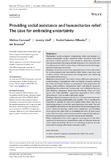| dc.contributor.author | Caravani, Matteo | |
| dc.contributor.author | Lind, Jeremy | |
| dc.contributor.author | Sabates-Wheeler, Rachel | |
| dc.contributor.author | Scoones, Ian | |
| dc.date.accessioned | 2022-01-13T12:53:31Z | |
| dc.date.available | 2022-01-13T12:53:31Z | |
| dc.date.issued | 2021-12-21 | |
| dc.identifier.citation | Caravani, M.; Lind, J.; Sabates-Wheeler, R. and Scoones, I. (2021)' Providing Social Assistance and Humanitarian Relief: The Case for Embracing Uncertainty', Development Policy Review, 40, e12613, DOI:10.1111/dpr.12613 | en |
| dc.identifier.uri | https://opendocs.ids.ac.uk/opendocs/handle/20.500.12413/17053 | |
| dc.description.abstract | Motivation
Social assistance and humanitarian relief in disaster response increasingly overlap, especially where recurrent crises and persistent conflicts prevail. In such situations, distinctions between risk and uncertainty become especially important. Shifting the focus from risk assessment and management to embracing uncertainty is important for policy and practice.
Purpose
The paper assesses the suitability of two approaches to social assistance and humanitarian relief where crises recur and conflicts persist: risk assessment and management; and embracing uncertainty and ignorance.
Methods and approach
We review different approaches to social assistance, humanitarian relief and disaster response, and ask how they are framed. We draw on experiences from social assistance, humanitarian relief and disaster response programmes, highlighting the professional, bureaucratic and institutional features that influence programme design and functioning. These are compared with ‘high-reliability’ approaches as deployed in other ‘critical infrastructures’ — such as water and energy supply.
Findings
Mainstream approaches centre on risk assessment and management, assuming predictability and stability. This is problematic, especially in settings of crisis and conflict where there may be no functioning delivery system for social assistance and relief. Alternatives to the mainstream risk-focused approaches are highlighted. These emphasise learning, collaboration, adaptation and flexibility. Such approaches must build on embedded practices of moral economy, collective action and mutual care and be supported through professional and institutional capacities that generate reliability.
Policy implications
We suggest a new agenda for the intersection of social assistance, humanitarian relief and disaster response, which makes uncertainty the focus for rethinking responses at scale, especially in crisis and conflict-affected settings. | en |
| dc.language.iso | en | en |
| dc.publisher | Wiley | en |
| dc.rights.uri | http://creativecommons.org/licenses/by/4.0/ | en |
| dc.subject | Security and Conflict | en |
| dc.title | Providing Social Assistance and Humanitarian Relief: The Case for Embracing Uncertainty | en |
| dc.type | Article | en |
| dc.rights.holder | This article is protected by copyright. All rights reserved | en |
| dc.identifier.externaluri | https://onlinelibrary.wiley.com/doi/abs/10.1111/dpr.12613 | en |
| dc.identifier.doi | 10.1111/dpr.12613 | |
| rioxxterms.funder | Default funder | en |
| rioxxterms.identifier.project | Default project | en |
| rioxxterms.version | VoR | en |
| rioxxterms.versionofrecord | 10.1111/dpr.12613 | en |
| rioxxterms.funder.project | 9ce4e4dc-26e9-4d78-96e9-15e4dcac0642 | en |


